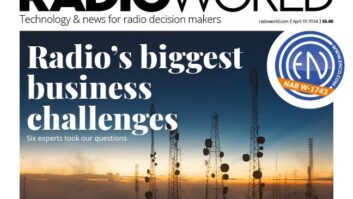The author heads Mullaney Engineering Inc. in Gaithersburg, Md.
A recent edition of Radio World contained a commentary by Phil Galasso titled “Expanding the FM Band Is a Great Idea — But Please Keep It Simple.”
I am a member of the Broadcast Maximization Committee, which filed the TV Channel 5–6 proposal in MB Docket 07-294, “Promoting Diversification of Ownership in Broadcasting Services.”
The BMC filing was intended to be a starting point for discussion on the reallocation of TV Channels 5–6 to be used as an expansion of the existing FM band.
After the digital transition, TV Channels 5 and 6 will be vacated by all except a small number of full-service TV stations, and of those remaining stations all could be relocated to other channels. Given that these two TV channels operate on 76–88 MHz, they are a natural extension of the FM band, which occupies 88–108 MHz.
With utilization of digital modulation techniques, BMC has determined that there is sufficient bandwidth to migrate as many of the nearly 3,900 existing AM stations that wish to become a digital FM facility and still have sufficient spectrum available to expand the non-commercial educational FM band while also reserving specific spectrum for low-power FM (LPFM), FM translators and event radio services.
There should even be spectrum available to permit some of the grandfathered short-spaced FM facilities in the existing FM band to migrate.
In response to statements raised by the guest commentary, BMC offers the following:
1. “Why is the BMC proposing that digital transmission be used exclusively for radio broadcasting in TV Channels 5–6?”
Like it or not, the world is going digital. If broadcasting wants to survive it must be able to compete on a level playing field with these new digital services (WiFi, WiMax, Internet, iPod).

This map shows just one of the 119 digital channels being populated with existing AM stations. Any location not within a circle is the potential location of an additional digital facility. Every one of the new digital channels will present opportunities for new entrants. Once a receiving device is able to decode a digital signal, it is a simple matter for it to automatically detect the various formats available (IBOC and DRM, for example). We hope that the Federal Communications Commission will mandate a modulation format that is not proprietary.
We considered utilizing the existing 200 kHz channel spacing but believe that there is just too much demand and that such a channel spacing would not create sufficient channels to meet that demand. We have initially proposed 100 kHz channel spacing but some believe that even 50 kHz should be investigated.
Given that the future is a digital world it seems only right to populate this new band from day one using digital rather than an inferior analog-digital hybrid that is being used in the existing FM band. Digital operation in the AM band is problematic during daytime and impossible during nighttime hours. AM stations need to move into this digital world if they are to survive.
Assuming broadcasters want IBOC to survive, it is essential that radio manufacturers start including a digital signal processor (DSP) in all domestic radios. If this happens, it is truly a simple matter to expand reception of those radios to include 76–88 MHz and detect whatever digital format is adopted by the FCC for this new band.
2. “The first AMs to migrate should be Class D (old IV) then Class B then Class C …”
BMC believes that there is sufficient spectrum to migrate the entire AM band and that a “nationwide allotment plan” needs to be developed for the most efficient migration. Thus, we feel there is no technical need to prioritize which class of AM is evaluated first under this plan.
BMC envisions circumstances where some AM stations (especially Class A 50 kW stations) would elect to remain in the existing analog AM band and not migrate to this new digital band. Thus, after migration, BMC supports not only re-farming stations (changing frequencies) that elect to remain in the AM band but also radical changes in co-channel and adjacent-channel interference protection, utilizing more realistic protection ratios and the protection of a more realistic noise-immune AM contour like 2 mV/m.
Increasing the maximum permissible power for the remaining AMs should also be explored. Existing band congestion and man-made electrical noise have placed the AM band on the verge of extinction.
Until the recent DTV transition plan, broadcast facilities in AM, FM and TV were basically added one at a time. Given the ever-increasing demand for new broadcast outlets in the limited spectrum allotted, a clearly thought out allotment plan is essential.
Similar to the process of securing an Expanded AM Band Frequency in the mid-1990s, a mechanism will need to be developed whereby existing AM stations, grandfathered FM facilities and others will indicate if they plan to migrate to this new digital band. If, at that point, demand exceeds capacity, some type of priority will need to be assigned to the various entities consistent with Section 307(b) of the Communications Act.
BMC takes no position on this and leaves it up to the FCC and its rule making process to implement this plan.
3. “Use existing FM band and phase out all FM translators …”
The existing FM band is congested in most, if not all, major population centers. However, given that it is only a matter of time before the FCC drops third adjacent-channel protections, BMC does not oppose a migration “drop-in” plan for new allotments which utilizes this existing spectrum (although selecting which AM stations get the analog drop-ins could be quite competitive).
We also believe that LPFM, FM translators, FM boosters and event radio facilities all provide needed and valuable service. Rather than ban such facilities in the future, BMC proposes dedicating several specific digital channels for nationwide operation by these secondary facilities.
Keeping secondary stations off channels normally used for full-service stations is best for both parties, but even more so for the secondary facilities, which are potentially subject to the most interference.
In the existing analog FM band, the movement to waive second adjacent protection is a mistake, especially when IBOC is considered. Perhaps moving FM translators and LPFMs to the newly vacated TV spectrum would eliminate the perceived need to compromise adjacent-channel protections to provide additional diversity.
Keeping secondary facilities on specific dedicated channels would also eliminate the need for the FCC staff to expend its limited resources reviewing the numerous petitions to deny.
4. “Why create new classes of FM stations?”
The BMC proposal was for “digital only” operation in this new expanded FM band, so utilization of the existing analog classes of ERP and HAAT limits did not appear to be a solution, especially when trying to replicate the coverage of AM stations.
It should be remembered that local conductivity and the specific AM frequency being replicated results in significantly different coverage areas. Thus, a 1 kW AM on 1500 kHz in Florida will have a substantially smaller coverage area than a 1 kW AM on 600 kHz in Florida or a 1 kW AM on 1500 kHz in North Dakota. These new classes will essentially result in a table of required separations but eventually, the FCC will need to implement contour protection as is done for non-commercial FM and AM allocations.
The digital station classes suggested in the BMC filing are nothing more than a starting point in an attempt at replication of the 2 mV/m AM service areas, which vary drastically across the country.
5. “Isn’t it time to stop using FM channel numbers and simply use the frequency?”
That is a good question: Who or what decides when the channel number or the actual frequency is used. Consumers use frequency for both AM and FM but use the channel number for TV. For some reason, the “experts” (consultant, attorneys and FCC staff) seem to differ only on FM by mainly referring to the channel number. However, after the digital TV transition, when the viewers in Washington think they are watching WRC(TV) Channel 4, they will really be watching TV Channel 48, yet the TV will still indicate Channel 4.
The better question is why we refer to the “FM band” when FM is really a modulation technique whereas 88–108 MHz is really part of the VHF band. So go figure.
BMC does not take a position on whether channel number or frequency ultimately is used in the future.
6. “Bottom of the new FM band should be restricted for use by local government alerts and the RDS standard should be modified to permit automatic tuning to certain frequencies during an emergency.”
BMC has proposed reserving the channels immediately below the existing FM band for facilities that operate at lower power (LPFM and FM translators) so as to minimize potential for adjacent-channel interference.
We do not believe it is necessary to do so at the bottom of this new band (near 76.1 MHz) given that the existing use is by 100 kW TV facilities. However, BMC is not opposed to some sort of restriction.
Establishing a requirement that all radios include an emergency alert function to be used by stations and police/fire is a great idea.
History has shown that the FCC has been extremely reluctant to issue rules on receiver characteristics and functions. Most recently in the DTV transition the commission initially decided not to require TV sets be capable of receiving both analog and digital signals. However, once it was obvious to everyone that the DTV transition was in grave danger of collapse, the commission adopted the requirement that every TV set be digital-capable. This late decision resulted in hundreds of millions of dollars of taxpayer money being needlessly poured into a public awareness and coupon program.
In MB Docket 08-172, the commission is evaluating whether to require the newly authorized satellite radio monopoly to include other services such as AM, FM and IBOC FM. Remember, it is really never too late to file “reply comments” in such a proceeding.
7. “Why not include other underutilized TV channels in the expansion of the FM band?”
MB Docket 07-294 specifically requested comments on using TV Channels 5–6 to expand the FM band, and that was the basis of the BMC response. Given that these channels are immediately below the existing FM band, use of those channels for expanding the FM band makes the most sense.
BMC believes that the few remaining full-service TV stations on Channels 5–6 can be relocated to other TV channels. However, in the case where no alternate channel is available for an existing TV Channel 5–6 station, BMC welcomes the inclusion of other underutilized TV channels for use by digital FM stations (such as TV Channel 4).
However, one must keep in mind that the lower the channel or frequency, the larger the wavelength, and thus, the multiple-bay FM antenna will not only be physically larger in length but will also be heavier. For the existing FM band (88–108 MHz) the approximate wavelengths vary from 9.1 to 11.2 feet, for TV Channel 5–6 it varies from 11.2 to 12.9 feet and for TV Channel 4 wavelengths will be as large as 14.9 feet or some 33 percent larger.
Again, BMC welcomes an open dialogue on its TV 5–6 proposal and emphasizes that its proposal is a starting point for discussion and that the time for this discussion is now!
While “Keep It Simple” is a good idea, an opportunity like this seldom comes around so “Let’s Make the Most of It.”












